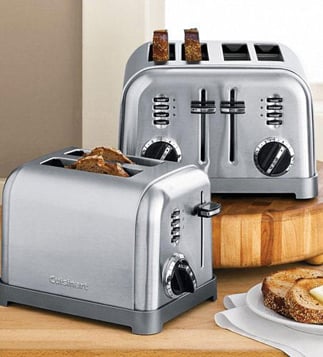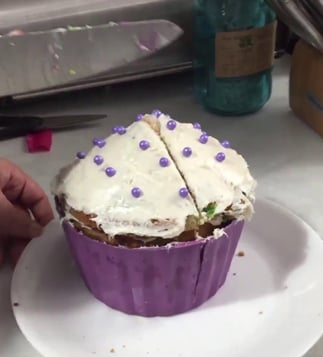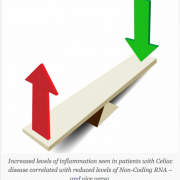Rethinking Cross Contamination – No Need to Be So Careful?
 A new, preliminary study from Children’s National Hospital published in the journal Gastroenterology found no significant gluten transfer when tools like the same toaster or knives are used for both gluten-free and gluten-containing foods.
A new, preliminary study from Children’s National Hospital published in the journal Gastroenterology found no significant gluten transfer when tools like the same toaster or knives are used for both gluten-free and gluten-containing foods.
- Children’s National Medical Center, medicalxpress.com 1
Preliminary study suggests that risk of gluten transfer in common-cooking activities may be lower than previously thought. Parents using multiple kitchen appliances and utensils to prevent their child with celiac disease from being exposed to gluten may be able to eliminate some cumbersome steps.
For the Canadian Celiac Association’s recommendations for preventing cross contamination, please scroll down to bottom of page.
The study authors found that performing these types of kitchen activities using the same kitchen equipment may not pose a high risk of gluten exposure for people with celiac disease. Additionally, basic kitchen hygiene, including routine washing of utensils and equipment with soap and water and hand washing, can further reduce or eliminate gluten transfer.
The authors tested three scenarios where it was thought that gluten transfer could be high enough to pose a gluten exposure risk for someone with celiac disease—in general, greater than 20 parts per million (ppm) or .002%. However, the study found less gluten transfer than expected in the following scenarios:
 Toasting bread: Gluten levels remained at less than 20 ppm when gluten-free bread was toasted in the same toaster as regular bread, across repeated tests and even when gluten-containing crumbs were present at the bottom of the toaster.
Toasting bread: Gluten levels remained at less than 20 ppm when gluten-free bread was toasted in the same toaster as regular bread, across repeated tests and even when gluten-containing crumbs were present at the bottom of the toaster.
Cupcakes: Gluten levels also remained below 20 ppm in most cases when a knife used to cut frosted gluten-containing cupcakes was then used to cut gluten-free cupcakes, even when visible crumbs were stuck to the icing on the knife.
Pasta: Cooking gluten-free pasta in the same water as regular pasta did cause significant gluten transfer, sometimes as high as 115 ppm. However, if the gluten-free pasta was rinsed under running tap water after cooking, the gluten transfer dropped to less than 20 ppm. If the pasta pot was simply rinsed with fresh water before being reused, then gluten transfer was undetectable.
“So many celiac parents, including me, have taken every precaution to prevent a gluten exposure in our homes. In many cases that means having two of everything—toasters, knives, and pasta pots, with little or no hard evidence showing we needed to,” says Vanessa Weisbrod, executive director of the Celiac Disease Program at Children’s National Hospital, who conceived and led the study.
“Though the sample is small, this study gives me hope that someday soon we’ll have empirical evidence to reassure the families we work with that their best defense is not two kitchens—it’s simply a good kitchen and personal hygiene. And, that we can travel to grandma’s house or go on a vacation without worrying about a second toaster.”
“These are areas of the kitchen where today we coach families to exercise an abundance of caution. We still recommend following all guidelines from your celiac care team to prevent cross contamination while we do further study,” adds Benny Kerzner, M.D., the study’s senior author and director of the Celiac Disease Program at Children’s National.
“But the results are compelling enough that it’s time for our larger celiac community to look at the current recommendations with a critical eye and apply evidence-based approaches to pinpoint the true risks for families and eliminate some of the hypervigilant lifestyle changes that we sometimes see after a family receives a celiac diagnosis.”
“This study provides novel data that quantifies the risk of gluten exposure when preparing gluten-free food alongside gluten-containing foods and highlights the need for further study in this area so that recommendations can be evidence-based,” notes Jocelyn Silvester, M.D., Ph.D. FRCPC, director of Research for the Celiac Disease Program at Boston Children’s Hospital who led the study’s biostatistical analysis.
The authors maintain that the most important thing families can do to prevent gluten reaction is practicing simple hygiene steps that include washing pots, pans and kitchen utensils with soap and water after each use (and before using them to prepare gluten-free food) and for all family members to wash their hands with soap and water before preparing gluten-free food.
“The treatment burden of maintaining a strict gluten-free diet has been compared to that of end-stage renal disease, and the partner burden to that of caring for a cancer patient,” says Marilyn G. Geller, chief executive officer of the Celiac Disease Foundation.
“This preliminary study is encouraging that this burden may be reduced by scientifically evaluating best practices in avoiding cross-contact with gluten. We congratulate the Children’s National Celiac Disease Program team in taking this important first step in bettering the lives of celiac disease patients and their loved ones.”
• SEE link to ‘A Quantitative Assessment of Gluten Cross-Contact in the School Environment for Children with Celiac Disease’
• SEE LINK to ‘Preparation of Gluten-Free Foods Alongside Gluten-Containing Food May Not Always Be as Risky for Celiac Patients as Diet Guides Suggest’
DISCUSSION:
- More information: Vanessa M. Weisbrod et al, Preparation of Gluten-Free Foods Alongside Gluten-Containing Food May Not Always Be as Risky for Celiac Patients as Diet Guides Suggest, Gastroenterology (2019). DOI: 10.1053/j.gastro.2019.09.007
- https://linkinghub.elsevier.com/retrieve/pii/S0016508519413401
- https://medicalxpress.com/journals/gastroenterology/
Preventing Cross Contamination 2
People who need to eat gluten free need to check both the ingredients in food and any cross-contamination with gluten-containing ingredients that might happen when the food is manufactured, packaged and prepared for eating.
When you think about avoiding cross-contamination, you need to realize that crumbs matter. Look around your kitchen to see where there are crumbs – on the counter top, in the microwave, on the cutting board or in the corners of your metal baking dishes? Anywhere you see crumbs is a potential place for cross-contamination.
At home the following practices will go a long way toward avoiding cross contamination:
- A celiac should have their own butter dish and a cutting board that is used for gluten free foods only.
- A celiac should have their own toaster. A toaster oven, where the rack can be removed and washed if others have used it may be a good alternative. If you do not have access to a separate toaster, try a toaster bag, a silicon bag that holds the bread while it is toasted. The bread toasts right through the bag.
- If it is not practical to have a section of the counter top set aside for preparing gluten free food only, always make sure that the counter space you are using to prepare gluten free food is freshly washed to ensure it is free from crumbs or flour dust.
- Do gluten free baking first, and have it well wrapped and stored before doing anything with regular flours. Flour dust (in the air) from regular flours could settle on the gluten free products, thus contaminating them.
- Note: Although this doesn’t fall into the cross contamination area, it is worth noting that a Celiac should take precautions against breathing in flour dust when using other than gluten free flours. Flour dust that settles on the nasal passages may eventually get swallowed and end up being digested.
- When making sandwiches, do the gluten free ones first – otherwise be sure to wash your hands after touching regular bread and before touching gluten free supplies.
- Use clean utensils and avoid “double dipping” – knives or spoons are OK the first time, but once they have touched food with gluten, they can contaminate the food in the container if used again. If it is too difficult to train other family members in this regard, it would be wise for the celiac to have their own jar of jam, peanut butter, mustard, etc.
- Be especially alert and cautious when you have guests helping in the kitchen – they will not have your gluten awareness. Also, it is when you are otherwise distracted that you are more likely to make a gluten error.
- Make sure any pots, utensils, etc. that are used for other foods are thoroughly scrubbed before using for gluten free foods. In the case of something like muffin tins, paper liners may be a worthwhile consideration.
- It is best to have a separate set of utensils with porous surfaces, such as wooden spoons, for your gluten free baking. These utensils might retain some gluten particles after cleaning.
- If using lentils, be sure to meticulously pick them over before putting in the pot to cook. Even if you buy them packaged, it is not uncommon to find kernels of wheat or oats (or pebbles) in with the lentils.
Away from home, be aware of sources of cross contamination:
- Products in bulk bins can become contaminated by using the scoops in more than one bin. There is no assurance that the other customers will be as cautious as you. Also, flour dust in the air around these bins can cause a problem.
- At the deli counter, where gluten free meats are being cut using the same utensils without cleaning in between or where cut meats often overlap on the counter.
- Buffet lunches, where the chef tests the temperatures in all the dishes using one thermometer, or spoons are used for more than one dish.
- French fries cooked in oil where battered foods have been fried.
- Meat cooked on a grill which hasn’t been cleaned after cooking regular food with gluten.
- Gluten-free pasta may be cooked in water used for regular pasta and rice may be cooked in broth containing gluten.
- Milling of gluten free grains on equipment that has been used for regular grains.
- In product production where a gluten free product is not produced on a dedicated line. Cereals and candy bars that have gluten free ingredients may be produced after a non GF item without having the equipment cleaned thoroughly in between.
1 https://medicalxpress.com/news/2019-09-preliminary-gluten-common-cooking-previously.html
2 https://www.celiac.ca/living-gluten-free/newly-diagnosed as adapted from an article prepared by the CCA Calgary Chapter http://www.calgaryceliac.ca/wp-content/uploads/2012/03/Contamination.pdf













